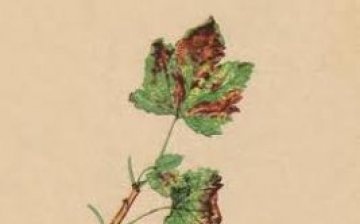Currant anthracnose
Currant anthracnose is a widespread disease. Anthracnose is characterized by the defeat of young shoots, petioles, leaves, stalks and berries. Dark brown small semicircular or rounded spots about one millimeter in diameter are formed on the leaves. Black tubercles appear with sporulation of the pathogen, the integumentary tissue of the tubercles breaks, they become white. Dark, depressed spots with slight sporulation appear on the petioles, stalks and shoots. Currant anthracnose less often affects berries, light brown, brown or black dots with a red border appear on them.
The causative agent of this disease is a marsupial mushroom, which is represented by several forms that affect red as well as black currants. The pathogen forms a mycelium, which is located in the intercellular spaces of plant tissues. The fungus forms macroconidia, and sometimes microconidia.
Conidia are spread by insects and raindrops. The incubation period of the disease is approximately twelve days. During the growing season, the fungus produces two generations of conidial sporulation. Currant anthracnose develops intensively in years with strong moisture. In dry, hot weather, anthracnose develops less frequently.
Currant anthracnose can often cause a strong leaf fall, the disease causes wilting of young shoots, and also significantly reduces the currant yield. This disease greatly reduces the winter hardiness of the currant.
There are no completely anthracnose-resistant currant varieties. Only some varieties have a certain resistance.



